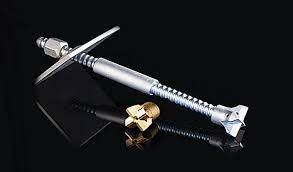In the ever-evolving landscape of construction and civil engineering, where the demand for robust and efficient foundation systems continues to rise, the advent of self-drilling hollow bar anchors has ushered in a new era of innovation. These anchors, often referred to as “hollow bars” or “threaded rods,” are designed to combine drilling and anchoring functions into a single, integrated process. Unlike traditional methods that involve drilling holes separately and subsequently installing anchors, self-drilling hollow bars streamline the entire process, significantly reducing both time and labor costs.
At the heart of these anchors lies a sophisticated engineering design. Comprising a hollow steel bar with an external thread and a sacrificial drill bit, self-drilling hollow bar anchors are engineered to penetrate soil or rock formations effortlessly. The drill bit, usually located at the leading end of the bar, is tailored to suit the specific geological conditions at the construction site. As the anchor is rotated and driven into the ground, the drill bit advances, creating a void and simultaneously exposing the hollow interior of the bar.
 This unique design allows for the injection of grout or cementitious material through the hollow center of the bar, ensuring optimal bonding between the anchor and the surrounding ground. The injected material serves the dual purpose of stabilizing the drilled hole and enhancing the load-bearing capacity of the anchor. This integrated drilling and grouting process make self-drilling hollow bar anchors particularly effective in challenging ground conditions, such as loose soils, sands, and fractured rock formations.
This unique design allows for the injection of grout or cementitious material through the hollow center of the bar, ensuring optimal bonding between the anchor and the surrounding ground. The injected material serves the dual purpose of stabilizing the drilled hole and enhancing the load-bearing capacity of the anchor. This integrated drilling and grouting process make self-drilling hollow bar anchors particularly effective in challenging ground conditions, such as loose soils, sands, and fractured rock formations.
One of the key advantages of these anchors is their versatility. Self-drilling hollow bars find application in a wide range of geotechnical and construction scenarios, including slope stabilization, tunneling, foundation underpinning, and retaining wall construction. Their adaptability, coupled with the efficiency gained through simultaneous drilling and anchoring, has made them a preferred choice in projects where speed, cost-effectiveness, and reliability are paramount.
In essence, the self-drilling hollow bar anchor represents a paradigm shift in foundation engineering. Its innovative design and multifaceted functionality not only simplify construction processes but also elevate the standards of geotechnical stability, making it a cornerstone in the contemporary toolkit of civil engineers and construction professionals.
Self-Drilling Hollow Bar Anchors | how do they work?
This blog explores the revolution in construction with self-drilling hollow bar anchors, seamlessly combining drilling and anchoring functions. These innovative anchors, featuring a hollow steel bar and integrated drill bit, streamline the process, significantly cutting costs and time. Their versatility extends to slope stabilization, tunneling, and retaining walls, setting a new standard for geotechnical stability in modern civil engineering projects.
